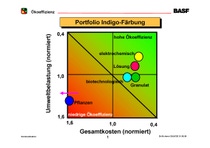Methods for quantifying sustainability
Is it even possible to quantify sustainable development? And if so, how?
Since 1996, BASF has been developing analysis and assessment methods in order to better record and understand its contribution to sustainability. The company is a pioneer in this field. Starting from methods for analyses at the product level, BASF increasingly concentrated on developing approaches that enable a holistic view to be taken.
The first step was the Eco-Efficiency Analysis devised by BASF in 1996. Its goal was to bring economic and environmental aspects into harmony. It allowed products and procedures to be compared in terms of economic efficiency and environmental compatibility and made BASF a pioneer in the measurement of sustainability.
BASF reported on one of its first Eco-Efficiency Analyses in a press release in 1999: It had analyzed various procedures for manufacturing indigo, a blue jeans dye and one of the milestones of its research history. This Eco-Efficiency Analysis also had practical results, on the basis of which BASF decided which process was to be used for indigo in the future.
Auch darüber hinaus zog BASF ihre Ökoeffizienz-Analyse zunehmend zur Bewilligung von Investitionsanträgen heran. Denn Nachhaltigkeitskriterien spielten eine immer wichtigere Rolle bei Investitionsentscheidungen.
And this was not an isolated case – BASF increasingly used its Eco-Efficiency Analyses for the approval of investment proposals. After all, sustainability criteria played an ever more important role in investment decisions. This was also the case for the development of new procedures and products, however, which is why BASF also considered environmental aspects in research projects from the beginning using the Eco-Efficiency Analysis. This even gave rise to a dedicated term with the promise of innovation-integrated environmental protection.
SEEbalance
As the Eco-Efficiency Analysis could only cover two of the three dimensions of sustainability, BASF further refined the method and unveiled SEEbalance in 2005. Social indicators were also incorporated into the analysis using this method.
AgBalance
In 2010, BASF initiated a new project with the specific aim of covering elements of sustainability in agriculture. The AgBalance method launched the following year analyzes sustainability specifically in agricultural production, and along the entire value chain.
Sustainable Solution Steering
BASF developed the Sustainable Solution Steering method in order to recognize the contribution each of its products makes to sustainability. Using this, the company has been managing its product portfolio while taking sustainability criteria into account since 2013. Accelerator products are especially important, as they make a particularly big contribution to sustainability in the value chain.
Value-to-Society
In 2013, BASF developed the Value-to-Society approach in order to record the contribution of its entrepreneurial actions, in other words the economic, environmental and social effects of its business activities along the entire value chain. This forms the basis for an end-to-end analysis of entrepreneurial value creation.
